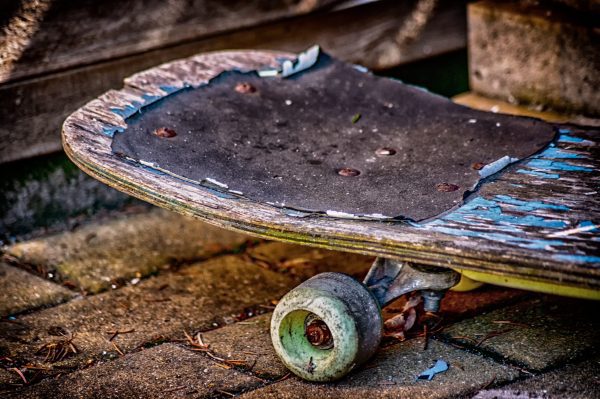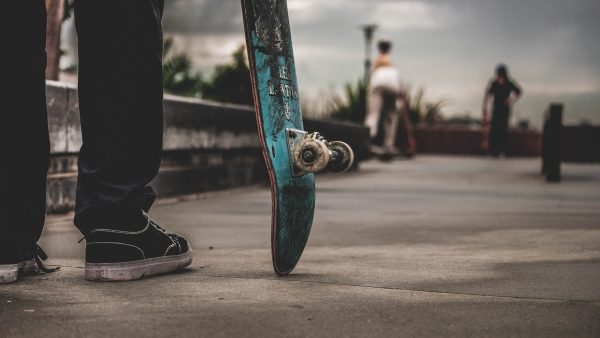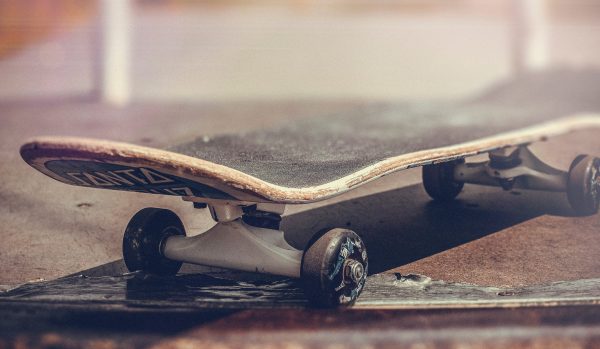Skateboard rider knows that the thrilling world of skateboard riding is not without its fair share of damages, bumps, scrapes, spills, or any damage. From conquering skateboard ollies to mastering the skateboard repair tricks, endure quite the beating in the hands of their skateboard riders with this repair guide.

But fear not, fellow skaters, for every scrape, crack, and chip can be remedied with a little know-how and a touch of elbow grease. In this comprehensive guide, we present to you the guides on how to repair skateboard damage, equipping you with the knowledge and techniques to resurrect your beloved skateboard from even the direst of conditions. Whether it’s a shattered deck, worn-out grip tape, loose trucks, or those pesky wheel bites, we’ve got you covered.
So, tighten your helmet straps, lace up your sneakers, and dive into the world of repairing skateboard damage. Let’s reclaim the streets, parks, and ramps with confidence, knowing that no crack, chip, or wheel bite can keep us from the endless thrill of skateboarding. Get ready to roll, because the only direction we’re headed is forward – fixing it up, one trick at a time!
Remember, depending on the severity of the damage and your skill level, repairs might take a few hours. Keeping your skateboard in top shape ensures a safer and more enjoyable skating experience.
Key Takeaways
- Regularly inspect your skateboard for common damage, such as cracked skate decks, worn-out skate grip tape, and loose skate trucks.
- Safety should always come first, so wear appropriate protective skate gear when conducting maintenance.
- Learn how to repair a damaged deck and transfer components to a new one.
- Repair damaged edges and tail with sandpaper and wood filler.
- Replace worn-out skate grip tape to maintain proper traction.
- Prevent skate wheel bite by using riser pads or adjusting skate truck tightness.
- Learn how to replace worn-out skate bearings and keep them clean and lubricated.
- Adjust skate truck tightness to customize the skateboard’s turning responsiveness.
- Consider professional help for complex repair maintenance or advice.
- Practice preventative maintenance repair to catch potential problems early on.
- Customize your setup with the right components to match your skateboarding style and preferences.
Understand Your Skateboard Parts
Understanding a skateboard’s anatomy is the cornerstone of responsible skateboarding. Knowing the skateboard anatomy fosters safety improves performance, facilitates maintenance, and empowers you to take charge of your skateboard’s care. Whether you’re a seasoned rider or a newcomer to the skateboarding world, learning the ins and outs of your skateboard will undoubtedly enhance your overall skateboarding experience.

The anatomy of skateboards consists of several key components that work together to create functional and rideable skateboards. Here are the main parts of standard skateboards:
- Deck: The deck is the main board of the skateboards, typically made of multiple layers of wood or composite materials like bamboo or fiberglass. It comes in various shapes, sizes, and concave profiles to accommodate different skateboarding styles. The deck provides the platform on which the rider stands and performs tricks.
- Grip Tape: Grip tape is a gritty, adhesive material applied to the top surface of the skateboard deck. It provides traction and grip for the rider’s shoes, helping to maintain control while riding and performing tricks.
- Trucks: Trucks are the metal T-shaped components mounted underneath the skateboard deck. They consist of an axle, a hanger, and a kingpin. Trucks connect the wheels to the deck and allow the board to turn and pivot.
- Wheels: Skateboard wheels are made of urethane and come in various sizes, durometers (hardness), and shapes. They are attached to the trucks’ axles and enable the skateboards to roll smoothly on various surfaces.
- Bearings: Skateboard bearings are small, circular components that fit inside the wheels’ hubs and allow them to spin freely around the axle. They consist of ball bearings encased in a metal or ceramic race. High-quality bearings reduce friction in the speed, leading to a smoother and faster ride alongside the high speeds.
- Risers: Risers are plastic or rubber pads placed between the skateboard deck and the trucks. They increase the distance between the wheels and the deck, reducing the risk of wheel bite (when the wheels contact the deck during sharp turns or tricks).
- Hardware: Skateboard hardware includes flat screws and nuts used to attach the trucks to the deck securely. Usually, skateboards have eight screws and nuts, four for each truck.
- Bushings: Bushings are small, rubbery components that sit inside the trucks’ kingpin and hanger. They are responsible for the skateboard’s turning responsiveness and can be adjusted to suit the rider’s preference.
These components work in unison to create well-balanced and functional boards. Skaters often customize their setups, choosing specific deck shapes, wheel sizes, and truck tightness to match their riding style and preferences. Understanding the anatomy of skateboards helps riders maintain their skateboards, diagnose issues, and make informed decisions when upgrading or customizing their setups.
Guides On How To Fix Skateboard Deck Damages
Repairing skateboard damages can be a valuable skill for skateboarders, as it allows them to extend the life of their skateboards and save money on replacements. Here are some essential guides to repairing skateboard damage:

- Identifying Damages: Learn to identify common skateboard damages such as cracked decks, worn-out grip tape, loose trucks, damaged wheels, and faulty bearings. Regularly inspect your skateboards to catch issues early, which can prevent more extensive damage.
- Safety First: Before attempting any maintenance, ensure you have the necessary safety equipment like gloves, eye protection, and a skateboard tool. Always work in a well-lit and open space to avoid accidents.
- Replacing Damaged Skate Deck: If your deck is cracked or broken beyond maintenance, learn how to transfer all components (trucks, wheels, bearings, grip tape) to a new skateboard deck. This involves detaching and reassembling all parts properly.
- Repairing Chipped Edges and Tail: Use sandpaper to smooth out chipped or damaged edges on the deck. A chipped edge may injure you unintentionally. For small chips on the tail, apply wood filler to fill in the damage and sand it down once dry.
- Replacing Grip Tape: Learn how to remove old grip tape and apply new grip tape correctly. Properly grip tape your deck to ensure a secure footing while riding.
- Repairing Wheel Bite: Prevent wheel bite by adding riser pads or adjusting truck tightness. If you already have wheel bite damage, learn how to repair the affected areas.
- Replacing Worn-out Bearings: Understand how to remove and replace bearings in your skateboard wheels. Clean and lubricate bearings regularly to maintain optimal performance.
- Tightening Loose Trucks: Learn to tighten or loosen truck kingpins to adjust the skateboard’s turning responsiveness according to your preference. Make sure everything is tight enough.
- Repairing Cracked or Broken Trucks: If your trucks are damaged beyond maintenance, know how to remove and replace them. Understand different truck sizes and styles to choose the right ones for your skateboard.
- Preventative Maintenance: Learn proper skateboard maintenance techniques like cleaning, lubricating, and checking for wear and tear regularly. Preventative maintenance can prevent significant damage and prolong your skateboard’s life.
- Customization and Upgrades: Understand how different components like wheels, bearings, and bushings affect the skateboard’s performance. Learn how to choose the right components to customize your setup to match your riding style.
- Seek Professional Help: While it’s essential to learn basic skateboard maintenance skills, some maintenance may require professional assistance. Don’t hesitate to take your skateboard to a local skate shop, hardware store, or a qualified technician for complex maintenance or advice.
By following these guides, you can ensure that your skateboard stays in top condition and serves you well for many shredding sessions to come. Remember, being careful with your wheels to prevent them from breaking caused by neglect and using a cleaner when needed is not only safer but also provides a more enjoyable riding experience.
Conclusion
Understanding how to repair a skateboard damage is an invaluable skill for any skateboarder. A well-maintained skateboard not only ensures a safer and more enjoyable riding experience but also saves money by extending the life of your beloved deck. By following the essential guides to repairing skateboard wrecks, you can become a true skateboard savior, capable of diagnosing issues, performing maintenance, and making necessary maintenance with confidence.
Starting with the fundamental anatomy of a skateboard, you can grasp the interplay between its components and appreciate how each part contributes to its overall performance. Armed with this knowledge, you can identify common board damages, from cracked decks to worn-out bearings, and address these issues promptly.
Safety should always be a priority, so remember to wear appropriate protective gear and work in a well-ventilated area when conducting skateboard maintenance. The right tools and precautions, including how to repair your skateboard and the best skateboards for adult ones, are essential when it comes to maintaining and ensuring the longevity of your skateboard, whether it’s brand new or previously damaged. It doesn’t matter if you have a type of skateboard, whether it’s for tricks or cruising, or if you’re an adult skateboarder with the best skateboard or a poor quality one; proper maintenance extends the life of your skateboard bearings, other skateboard parts, and ensures safe rides at the skate park.
Embracing preventative maintenance is key to preserving your skateboard’s longevity. Regular cleaning, lubrication, and inspection will help you catch potential problems early on and prevent more severe damage.
Moreover, learning the art of skateboard customization and upgrades empowers you to tailor your ride to your style and preferences. Whether you’re a seasoned pro or a novice rider, a custom setup can take your skateboarding experience to new heights.
While learning how to repair skateboard damage is essential, some maintenance may be beyond your expertise. Don’t hesitate to seek help from experienced technicians or local skate shops when needed.
In the end, a well-cared-for skateboard becomes more than just a piece of equipment—it becomes an extension of your passion and a reflection of your dedication to the sport. So tighten those trucks, repair those chips, and repair those bearings—your skateboard is waiting to hit the pavement once more, ready to accompany you on countless thrilling adventures in the world of skateboarding. Happy shredding!
Frequently Ask Questions (FAQs):
Can You Fix A Broken Longboard?
Yes, you can often repair a broken skateboard depending on the extent of the damage. If the skateboard deck has a minor crack or split, you can use “wood glue” to mend the broken parts together. Apply the glue evenly and firmly press the pieces together, then allow sufficient time for it to dry and bond.
How Do You Fix Longboard Chips?
Small damages can happen. Repairing skateboard chips is a relatively straightforward process. First, clean the damaged area with damage and remove any loose debris. Apply “excess glue” to the chip and press it back into place firmly. Wipe off any glue that squeezes out and let it dry thoroughly on a “flat surface.”
How Do You Fix A Broken Deck Board?
To repair a broken deck skateboard, you can start with a “simple repair” if the damage is not extensive. Clean the broken edges and apply strong wood glue into the crack using a “meat syringe” or similar tool to ensure precise application. Press the broken pieces together firmly and wipe off any excess glue. Place a “heavyweight object” on top or middle of the mended area and let it dry completely for several hours or as per the glue manufacturer’s instructions.
What To Do If Your Longboard Has Cracks?
If your skateboard cracks, it’s essential to address the issue promptly. First, thoroughly inspect the crack to determine its severity and location. If the crack is on the deck, you may need to replace it entirely, as attempting to repair a cracked deck can compromise safety and performance. However, if the crack is in non-structural components like “truck hanger,” you can consider replacing just the affected part.
How To Fix Old Longboard?
Repairing an old street surfing board involves several steps to ensure it functions optimally. Firstly, inspect all “metal parts,” such as the trucks and bearings, for signs of wear or damage. Clean and lubricate the bearings to improve their performance. If any “replacement parts” are necessary, such as worn-out wheels or cracked trucks, be sure to use high-quality replacements to maintain the skateboard’s integrity.
Can Longboards Go Over Cracks?
Skateboards can generally go over small cracks in the ground without much trouble. However, when it comes to riding or skating on cracked street surfing board decks, caution is necessary. If the deck has minor cracks, one “way to repair” it is by applying epoxy to reinforce the affected area and prevent further wrecking. However, if the deck has a significant “delaminated area” or severe cracks, it’s safer to replace it entirely as it can compromise the board’s integrity and lead to accidents.
How Do You Repair Chipped Wood?
Repairing chipped wood is a relatively straightforward process. Start by cleaning the chipped area to remove any dirt or debris. Next, “apply epoxy” or fill the chip with wood filler that matches the color and type of wood. Apply the filler evenly and level it with the surrounding surface using a putty knife. Allow the filler to dry completely as per the manufacturer’s instructions. Once dried, sand the fixed area gently using fine-grained grit sandpaper to make it smooth and blend it with the rest of the wood surface. Properly repairing chipped wood will restore the appearance and integrity of the wood and prevent further wrecking. For precision, you can use a utility knife to trim any excess filler before letting it dry.
How Do You Repair Ceramic Chips?
Repairing ceramic chips can be done effectively with the right approach. First, clean the chipped area and remove any loose fragments. Choose a ceramic maintenance kit or epoxy specifically designed for ceramic surfaces, ensuring it matches the color of your ceramic item. Carefully fill the chip with the chosen fixed material, using a toothpick or small brush for precise application. Allow the epoxy or maintenance material to dry completely according to the manufacturer’s instructions. Once dried, gently sand any excess material and buff the fixed area to create a smooth finish. Properly repairing ceramic chips will restore the appearance of the item and maintain its functionality.
How Do You Repair A Small Wood Chip?
Repairing a small wood chip is a simple process. First, clean the chipped area and remove any loose wood fibers. Next, apply wood filler or putty that matches the color and type of wood to fill the chip. Use a putty knife to spread the filler evenly and level it with the surrounding surface. Allow the filler to dry completely as per the manufacturer’s instructions. Once dried, sand the fixed area gently to create a smooth finish and blend it with the rest of the wood surface. Properly repairing a small wood chip will restore the appearance and integrity of the wood, leaving it ready for finishing or painting if desired.
Will Water Ruin Grip Tape On A Skateboard?
Yes, water can ruin or damage the grip on a skateboard. Skateboard grip tape is designed to provide traction and grip for your feet while riding, but it is not water-resistant. When water comes into contact with the grip tape, it can cause it to lose its effectiveness and become less grippy. Riding a wet skateboard with compromised grip tape can be dangerous as it may lead to slips, falls, and loss of control. To maintain optimal grip and prolong the lifespan of your grip tape, it’s best to keep your street surfing board dry and avoid riding in wet conditions such as in the rain. Dry them up with a paper towel if it happens to get wet.
How Can I Repair Damage To My Skateboard At Home?
Look over the edge and surface of your board to locate the damaged sections. Clean up any chips or cracks and, depending on the extent and size of the damage, fill them with wood filler. To keep its form, apply a thin coating of filler. Once dry, use fine-grained sandpaper to smooth out the area. If your wheels have flat patches, you might have to replace them all. Don’t forget to have your tools open and available. Your skateboard will stay in good shape with regular maintenance and appropriate storage.
Last Updated on June 14, 2024 by Bernadine Racoma
DISCLAIMER (IMPORTANT): This information (including all text, images, audio, or other formats on FamilyHype.com) is not intended to be a substitute for informed professional advice, diagnosis, endorsement or treatment. You should not take any action or avoid taking action without consulting a qualified professional. Always seek the advice of your physician or other qualified health provider with any questions about medical conditions. Do not disregard professional medical advice or delay seeking advice or treatment because of something you have read here a FamilyHype.com.